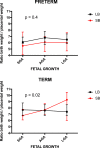Altered fetal growth, placental abnormalities, and stillbirth
- PMID: 28820889
- PMCID: PMC5562325
- DOI: 10.1371/journal.pone.0182874
Altered fetal growth, placental abnormalities, and stillbirth
Abstract
Background: Worldwide, stillbirth is one of the leading causes of death. Altered fetal growth and placental abnormalities are the strongest and most prevalent known risk factors for stillbirth. The aim of this study was to identify patterns of association between placental abnormalities, fetal growth, and stillbirth.
Methods and findings: Population-based case-control study of all stillbirths and a representative sample of live births in 59 hospitals in 5 geographic areas in the U.S. Fetal growth abnormalities were categorized as small (<10th percentile) and large (>90th percentile) for gestational age at death (stillbirth) or delivery (live birth) using a published algorithm. Placental examination by perinatal pathologists was performed using a standardized protocol. Data were weighted to account for the sampling design. Among 319 singleton stillbirths and 1119 singleton live births at ≥24 weeks at death or delivery respectively, 25 placental findings were investigated. Fifteen findings were significantly associated with stillbirth. Ten of the 15 were also associated with fetal growth abnormalities (single umbilical artery; velamentous insertion; terminal villous immaturity; retroplacental hematoma; parenchymal infarction; intraparenchymal thrombus; avascular villi; placental edema; placental weight; ratio birth weight/placental weight) while 5 of the 15 associated with stillbirth were not associated with fetal growth abnormalities (acute chorioamnionitis of placental membranes; acute chorioamionitis of chorionic plate; chorionic plate vascular degenerative changes; perivillous, intervillous fibrin, fibrinoid deposition; fetal vascular thrombi in the chorionic plate). Five patterns were observed: placental findings associated with (1) stillbirth but not fetal growth abnormalities; (2) fetal growth abnormalities in stillbirths only; (3) fetal growth abnormalities in live births only; (4) fetal growth abnormalities in stillbirths and live births in a similar manner; (5) a different pattern of fetal growth abnormalities in stillbirths and live births.
Conclusions: The patterns of association between placental abnormalities, fetal growth, and stillbirth provide insights into the mechanism of impaired placental function and stillbirth. They also suggest implications for clinical care, especially for placental findings amenable to prenatal diagnosis using ultrasound that may be associated with term stillbirths.
Conflict of interest statement
Figures


References
-
- Lawn JE, Blencowe H, Waiswa P, Amouzou A, Mathers C, Hogan D, et al. Stillbirths: rates, risk factors, and acceleration towards 2030. Lancet. 2016;387(10018):587–603. doi: 10.1016/S0140-6736(15)00837-5 . - DOI - PubMed
-
- MacDorman MF, Gregory EC. Fetal and Perinatal Mortality: United States, 2013. National vital statistics reports: from the Centers for Disease Control and Prevention, National Center for Health Statistics, National Vital Statistics System. 2015;64(8):1–24. . - PubMed
-
- Qureshi ZU, Millum J, Blencowe H, Kelley M, Fottrell E, Lawn JE, et al. Stillbirth should be given greater priority on the global health agenda. BMJ. 2015;351:h4620 doi: 10.1136/bmj.h4620 ; PubMed Central PMCID: PMC4707511. - DOI - PMC - PubMed
-
- Bukowski R, Carpenter M, Conway D, Coustan D, Dudley DJ, Goldenberg RL, et al. Causes of Death Among Stillbirths. JAMA. 2011;306(22):2459–68. doi: 10.1001/jama.2011.1823 - DOI - PMC - PubMed
-
- Stillbirth Collaborative Research Network Writing Group. Association between stillbirth and risk factors known at pregnancy confirmation. JAMA. 2011;306(22):2469–79. doi: 10.1001/jama.2011.1798 ; PubMed Central PMCID: PMC3807602. - DOI - PMC - PubMed
MeSH terms
Grants and funding
LinkOut - more resources
Full Text Sources
Other Literature Sources
Medical

